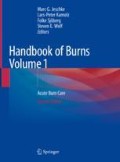Abstract
Chemical burns are caused by corrosive agents (acids and alkali) leading to tissue damage. These injuries comprise 10% of burn injuries with majority occurring due to household accidents, work accidents or even self-inflicted. The total body surface area (TBSA) involved in these injuries is usually less than thermal injuries; however, the depth and the extent of injuries could be more extensive than the thermal counterparts. In addition, special organs involvements such as eye, mucosa, or even renal and hepatic could have substantial subsequences. A review of common injuries involving acids, bases and the special considerations in decontamination and treatment of special agents are discussed in this chapter.
Access this chapter
Tax calculation will be finalised at checkout
Purchases are for personal use only
References
Pruitt BA Jr. The burn patient: I. Initial care. Curr Probl Surg. 1979;16(4):1–55.
Kaufman T, Ullmann Y, Har-Shai Y. Phosphorus burns: a practical approach to local treatment. J Burn Care Rehabil. 1988;9(5):474–5.
Larson DL, Abston S. Acutely burned patient. Initial care and closure of burn wound. N Y State J Med. 1970;70(12):1626–33.
Sykes RA, Mani MM, Hiebert JM. Chemical burns: retrospective review. J Burn Care Rehabil. 1986;7(4):343–7.
Xiang H, et al. Work-related eye injuries treated in hospital emergency departments in the US. Am J Ind Med. 2005;48(1):57–62.
Morgan SJ. Chemical burns of the eye: causes and management. Br J Ophthalmol. 1987;71(11):854–7.
Dua HS, King AJ, Joseph A. A new classification of ocular surface burns. Br J Ophthalmol. 2001;85(11):1379–83.
Gumaste VV, Dave PB. Ingestion of corrosive substances by adults. Am J Gastroenterol. 1992;87(1):1–5.
Poley JW, et al. Ingestion of acid and alkaline agents: outcome and prognostic value of early upper endoscopy. Gastrointest Endosc. 2004;60(3):372–7.
Osman M, et al. Responses of the murine esophageal microcirculation to acute exposure to alkali, acid, or hypochlorite. J Pediatr Surg. 2008;43(9):1672–8.
Zargar SA, et al. The role of fiberoptic endoscopy in the management of corrosive ingestion and modified endoscopic classification of burns. Gastrointest Endosc. 1991;37(2):165–9.
Mutaf O, et al. Gastroesophageal reflux: a determinant in the outcome of caustic esophageal burns. J Pediatr Surg. 1996;31(11):1494–5.
ASGE Technology Committee, et al. Drug-eluting/biodegradable stents. Gastrointest Endosc. 2011;74(5):954–8.
Gunel E, et al. Effect of antioxidant therapy on collagen synthesis in corrosive esophageal burns. Pediatr Surg Int. 2002;18(1):24–7.
McGrath K, Brazer S. Combined antegrade and retrograde dilation: a new endoscopic technique in the management of complex esophageal obstruction. Gastrointest Endosc. 2002;56(1):163–4.
Bueno R, et al. Combined antegrade and retrograde dilation: a new endoscopic technique in the management of complex esophageal obstruction. Gastrointest Endosc. 2001;54(3):368–72.
Mukherjee K, et al. Antegrade and retrograde endoscopy for treatment of esophageal stricture. Am Surg. 2008;74(8):686–7; discussion 688
Jelenko C 3rd, Story J, Ellison RG Jr. Ingestion of mineral acid. Am Surg. 1974;40(2):97–104.
Jelenko C 3rd. Chemicals that “burn”. J Trauma. 1974;14(1):65–72.
Palao R, et al. Chemical burns: pathophysiology and treatment. Burns. 2010;36(3):295–304.
Sheridan RL, et al. Emergency management of major hydrofluoric acid exposures. Burns. 1995;21(1):62–4.
Husain MT, Hasanain J, Kumar P. Sulphuric acid burns: report of a mass domestic accident. Burns. 1989;15(6):389–91.
Eldad A, et al. Phosphorous pentachloride chemical burn—a slowly healing injury. Burns. 1992;18(4):340–1.
Eldad A, Simon GA. The phosphorous burn—a preliminary comparative experimental study of various forms of treatment. Burns. 1991;17(3):198–200.
Solem LD. Emergent management of chemical burns. West J Med. 1987;147(3):308.
Benmeir P, et al. Chemical burn due to contact with soda lime on the playground: a potential hazard for football players. Burns. 1993;19(4):358–9.
Papini RP. ‘Is all that’s blistered burned?’ … a case of kerosene contact burns. Burns. 1991;17(5):415–6.
Lin CH, Yang JY. Chemical burn with cresol intoxication and multiple organ failure. Burns. 1992;18(2):162–6.
Author information
Authors and Affiliations
Editor information
Editors and Affiliations
Rights and permissions
Copyright information
© 2020 Springer Nature Switzerland AG
About this chapter
Cite this chapter
Izadpanah, A. (2020). Chemical Burn: Diagnosis and Treatments. In: Jeschke, M., Kamolz, LP., Sjöberg, F., Wolf, S. (eds) Handbook of Burns Volume 1. Springer, Cham. https://doi.org/10.1007/978-3-030-18940-2_40
Download citation
DOI: https://doi.org/10.1007/978-3-030-18940-2_40
Published:
Publisher Name: Springer, Cham
Print ISBN: 978-3-030-18939-6
Online ISBN: 978-3-030-18940-2
eBook Packages: MedicineMedicine (R0)

